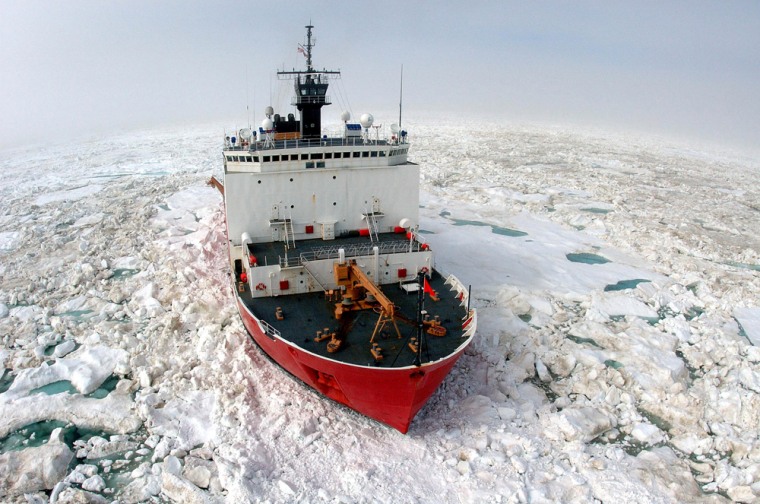Critical Arctic sea ice this winter made a tenuous partial recovery from last summer's record melt, federal scientists said Tuesday, but the thickest, oldest and toughest sea ice is undoubtedly melting — a bad sign for the future of the Arctic ice cap.
"Thickness is an indicator of long-term health of sea ice, and that's not looking good at the moment," Walt Meier of the National Snow and Ice Data Center told reporters in a telephone briefing.
Meier said the ice is very thin and vulnerable to heavy melting again this summer.
Overall, Arctic sea ice has shrunk precipitously in the past decade and scientists blame global warming caused by humans.
Melting Arctic ice does not raise sea levels as the melting of glaciers on Greenland or Antarctica could, but it does contribute to global warming when reflective white ice is replaced by dark water that absorbs the sun's heat.
Last summer, Arctic ice shrank to an area that was 27 percent smaller than the previous record. This winter, it recovered to a maximum of 5.8 million square miles, up 4 percent and the most since 2003, NASA ice scientist Josefino Comiso said. It is still a bit below the long-term average level for this time of year.
"What's going on underneath the surface is really the key thing," Meier said in an interview following a news conference. What's happening is not enough freezing.
Ice tied to world weather
Summer Arctic sea ice is important because it's intricately connected to weather conditions elsewhere on the globe. It affects wind patterns, temperatures farther south and even the Gulf Stream, acting as a sort of refrigerator for the globe, according to scientists.
"What happens there, matters here," said Waleed Abdalati, chief ice scientist at NASA's Goddard Space Flight Center in Greenbelt, Md. "Climate for the period of human record has depended on the ice being there."
Viewing the Arctic from space via NASA satellites might make you think the Arctic ice cover is on its way back.
But more than 70 percent of that sea ice is new, thin and salty, having formed only since September, Comiso said. The more important ice is perennial sea ice that lasts through the summer, and that ice has hit record low levels.
Half of perennial sea ice lost since '80s
Compared to the 1980s, the Arctic has lost more than half of its perennial sea ice and three-quarters of its "tough as nails" sea ice that is six years or older, Meier said. The amount of lost old sea ice is twice the area of the state of Texas, he said.
This doesn't mean the Arctic is open water during the winter, but it does mean that in many areas, the stronger perennial ice is being replaced by younger, frailer new ice that is more easily disturbed by wind and warm sea temperatures.
On top of that, a change in Arctic atmospheric pressure this winter is pushing a large amount of the valuable older ice out of the Arctic to melt, Meier said.
"It's like looking at a Hollywood set," Meier said of an Arctic largely covered with younger ice. "It may look OK but if you could see behind you'd see ... it's just empty. And what we're seeing with the ice cover is it's becoming more and more empty underneath the ice cover."
'World of hurt this summer'
That means next summer when temperatures warm, expect lots of melting, the scientists said.
"We're in for a world of hurt this summer," ice center senior scientist Mark Serreze told The Associated Press. Depending on the weather, there could be as much melting this year as last, maybe more, Serreze and Meier said.
At the South Pole, in Antarctica, sea ice seems stable, even slightly above normal, the scientists reported. However, ice levels in Antarctica always are quite different from the Arctic and aren't as connected to the world's weather.
And the scientists noted sharp warming on the Antarctic Peninsula, which stretches northward from the southern continent toward South America.
